When students living on campus turn their radio dials to 730-AM they expect to hear WQHS, the University's student-run radio station. But many hear nothing but static. The problem, according to WQHS Station Manager Stuart Sperling, is the 17-year-old broadcasting equipment located underneath campus residences. Sperling said the transmitters, which were installed when WQHS was formed in 1974, are outdated and are often overpowered by stronger electrical currents, such as microwave ovens and hair dryers. He also said much of the broadcasting equipment no longer works. According to College junior Sperling, WQHS's current problems prevent most University students from listening to the station's programs. To combat their escalating technical problems, WQHS members requested over $14,000 from the Student Activities Council's Finance Committee on Saturday to install new equipment in seven residence halls across campus. "We want to be a significant part of the University," Sperling said. "As a student-run University radio station, we should be able to link students together as a group. With our technical problems, we're not able to do that effectively." SAC Finance Committee Chairperson Howard Radzely said last night the committee will recommend that WQHS receive $11,560 for the new system. "We thought it was a worthwhile expense," Wharton junior Radzely said. "We felt that the change in equipment was needed for the group to exist." The radio station's funding request included the estimate to install transmitters in the Graduate Towers, but Radzely said the request was denied because SAC funds are restricted to undergraduate activities. WQHS runs on a carrier current system, in which electrical wiring serves as an antenna to provide coverage in buildings equipped with transmitters. Seven dormitories -- the Quadrangle, the High Rises, Hill House, Stouffer Triangle, and English House -- contain the necessary equipment, but all or parts of five of them cannot receive the station. LPB Inc., an engineering firm hired by WQHS to estimate the cost of the new system, said installing the transmitters will cost approximately $14,000, including Graduate Towers. WQHS applied for money from SAC's contingency budget, which consists of funds remaining after groups receive their funding for the year. The full body of SAC will vote on the proposal at tonight's monthly meeting. Radzely said SAC members usually give groups the amount of money the finance committee recommends. Sperling said he thinks the new equipment will increase interest in WQHS, both for people who work at the station, and for the University at large. "Just think of waking up each morning and hearing a student-run morning show," Sperling said. "You could feel like part of an institution." He added that improving the quality of transmissions is one of his goals for the radio station. He also wants to help more students to learn about the workings of radio broadcasting by strengthening WQHS's ties to WXPN, the University's professional radio station. Station members are also developing a way to extend service to off campus students, who make up half of the student body, Sperling said.
The Daily Pennsylvanian is an independent, student-run newspaper. Please consider making a donation to support the coverage that shapes the University. Your generosity ensures a future of strong journalism at Penn.
DonatePlease note All comments are eligible for publication in The Daily Pennsylvanian.







